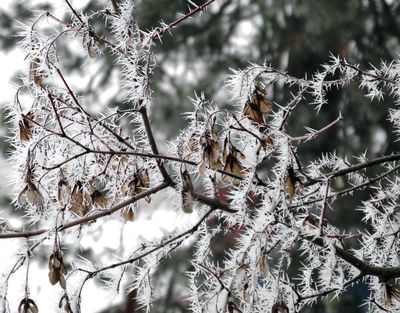Gardening: Remember to enjoy the beauty of winter

Last week’s temperature inversion locked us into a series of cold, foggy days that never seemed to end. The days were a little boring until the sun finally came back out.
However the misty fog coupled with freezing temperatures for almost a week left us a beautiful present. They decorated the landscape with a stunning coating of hoar frost that turned the place into a winter wonderland. Each day the fog hung around the landscape grew more beautiful as the ice crystals grew longer and longer.
Hoar frost occurs anytime the temperature has been below freezing long enough to cool down everything outdoors. On a clear night the earth, and objects on it, radiate heat into the atmosphere, making the earth colder than the surrounding air.
As heat radiates, the air temperature drops close to the dew point well below freezing, and it becomes supersaturated. The water vapor held in the air near these colder surfaces can’t remain as vapor so it condenses out of the air and forms ice crystals on the branches, grasses and fences. Dry air may leave a light coating while moist air will deposit a fairly thick layer of crystals on the surface.
If the temperatures stay cold and water vapor is present in high enough concentrations, these ice crystals will continue to grow into interlocking six-sided crystals. This was the case last week as nearly constant fog kept moisture levels in the air high for several days. As a result the continuing formation of ice crystals created some impressive long spikes, flakes and plates growing on all kinds of surfaces.
Like snowflakes, no two ice crystals will look the same. Subtle changes in the air’s moisture content, wind and temperature can alter how the crystals form and grow. They can change from needles to plates; change their growth direction and branch or get smaller or larger in size. The result is a rind on a surface or a branch that is a beautiful, lacy and fragile cluster of white crystals.
When the sun finally came out, it didn’t take long for the hoar frost to disappear. The process that formed the crystals merely reversed and sublimated the ice to water vapor again. If conditions are right, you might be lucky to see a fine fog rise off the plants as this happens. The tiny water vapor molecules may even create faint circular rainbows as the vapor refracts the sunlight.
So where does the word “hoar” come from? Some experts say it comes from an old English term referring to age. The hoar frost puts a white beard on everything as if the landscape were aging as we watched.
Regardless of the science behind last week’s beauty, we still need to find a minute to stop and appreciate it. Hoar frost like this disappears in a matter of minutes when the weather and temperature change. Much of the beauty of winter is fleeting and must be enjoyed in the moment.